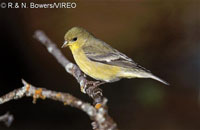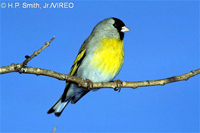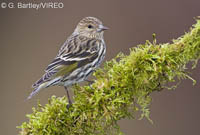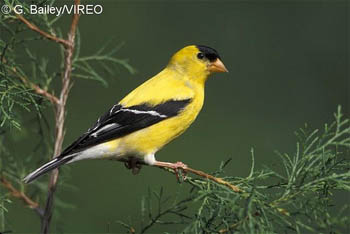Loading ...
American Goldfinch
The American Goldfinch (Carduelis tristis), sometimes called the "Wild Canary", is a year-round resident in most of the northern two-thirds of the United States. Its summer plumage is more typical of a bird of the neotropics: brilliant yellow body and jet black wings and forehead, while itís winter plumage is drab gray, brown and white. Goldfinches are highly gregarious, feeding communally in summer on seeds and cones, and flocking in dozens to bird feeders in winter to eat thistle and sunflower seed. The American Goldfinch is a decidedly vocal bird, constantly twittering to each other, calling "sweet-sweet-sweet", and periodically, an ascending, slurred "tsee-eee". In summer, the Goldfinch sings a distinctive "ti-dee-dee-dee" synchronized with each undulation of its dipping flight.
See all of the American Goldfinch photosField Marks:
The breeding male Goldfinch has a lemon yellow body, black forehead and wings, thin white wing bars, pink conical bill and notched tail. The female and winter male show gray-brown in place of most of the yellow. (L 5 in.)
Distribution:
The American Goldfinch is a year-round resident from Nova Scotia to Georgia and west to the Pacific. It winters in the southern U.S. and along the Gulf Coast to Veracruz, Mexico, and is a summer resident in the Dakotas, Montana, and Canada.
Similar Species:
 |
Lesser Goldfinch (all photos)
The Lesser Goldfinch in the western U.S and Mexico is smaller and has a somewhat heavier, dark bill, and black or olive back |
 |
Lawrence's Goldfinch (all photos) The Lawrence's Goldfinch, found in parts of Arizona and California, is distinctly gray on its back and head. |
 |
Pine Siskin (Species account) (all photos) The Pine Siskin winters in the Eastern and Central U.S. and often flocks with American Goldfinches. It has fine brown streaking with yellow highlights in the flight feathers, a sharp pencil-point bill and a buzzier ascending call "zreeee". |
Habitat & Nesting:
The American Goldfinch nests in orchards and open areas in proximity to its preferred food: the seeds of elm, alder, and coniferous trees, thistles and other weeds.
More Information:
The Goldfinch uniquely delays its breeding cycle until the late summer (mid-August in the East), apparently to guarantee that it will have plenty of seed to feed its young.

